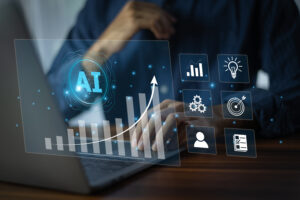*I frequently get asked questions about Data Science, so in the interest of helping as many people as possible, I’ve started this blog to answer those questions as simply as possible. This is a robust topic, and if you want a more in-depth discussion, please revisit my blog, where we will be going into greater depth at another time.
Data science vs. data analytics – how are they different? Data can be precious to businesses in improving their decision-making and operations. However, you must know the differences between the two fields, especially if you’re interested in a data-focused career.
Data science vs. data analytics — while the two may seem interchangeable, they have several differences. Both fields work with big data and the insights that can be gathered from it, but each has a unique approach.
In a data-driven world, it’s essential to understand all facets of data and the different ways to work with it. This article will help you understand data science vs. data analytics. Let’s begin.
Table of Contents
How Data Science Relates to Data Analytics
Data Science vs. Data Analytics
#4. Education and Skill Requirements
Data Science vs. Data Analytics: How Skillsets Compare
What is Data Science?
Data science is the study of data, often in large volumes. It combines math, statistics, specialized programming, artificial intelligence, and machine learning to uncover actionable insights within the data. Data scientists can use the information to drive decision-making and planning.
Data science vs. data analytics is a complex subject. The insights gathered from examining a company’s data can help increase operational efficiency. It also allows teams to identify new opportunities, improve marketing and sales, and build a competitive advantage.
Data science also includes other disciplines like data engineering, data preparation, data mining, predictive analytics, and data visualization — all of which are typically completed by skilled data scientists. It plays an important role in several aspects of a business, helping you gather information on customers to create robust and targeted advertising or increased conversions. It can also help detect financial fraud and block cyber-attacks.
Regarding business operations, data science can help optimize your supply chains, inventory, distribution, and customer service with more efficiency and lower costs. Ultimately, when you pay attention and gather insights from your data, it can lead you to more informed decision-making and strategic planning. Without data insights, you could miss out on opportunities, subjecting your business to avoidable mistakes.
How Data Science Relates to Data Analytics
“Because data can be so vast and complex, there are specific processes data scientists follow.”
The methodology provides a structured framework and systematic approach to working with data sets and gathering insights. This is commonly referred to as data analytics.
The data science process, or data science life cycle, has several steps, including:
- Frame the Problem
- Collect the Data
- Clean Up the Data
- Analyze the Data
- Communicate Findings
#1. Frame the Problem
The first step in the process is framing the problem you’re setting out to solve or identifying the question you’re hoping to answer. This step is similar to the hypothesis stage of the scientific method and sets the stage for the rest of the process.
#2. Collect the Data
Next, you need to collect the appropriate data. This is typically raw data that’s either structured or unstructured and should be relevant to the framing you set up in step one. You can collect data by scanning internal databases like customer relationship management (CRM) or purchasing databases externally.
#3. Clean Up the Data
After collecting data, you need to clean or process it. Most of the data you collect will likely be unstructured, irrelevant data you don’t need. The cleaning step also removes any duplicate values in the data set, missing entries, or improper formatting.
#4. Analyze the Data
Once all your data is cleaned up and prepped, you can start analyzing it. Often called an exploratory data analysis (EDA), this step allows you to identify valuable insights that will be useful later. It also requires a lot of mathematical and statistical knowledge. Thus, you’ll need to use several data analysis tools, including predictive analysis, regression, and qualitative analysis.
FACT: This is where there’s a bit of a crossover between data science vs. data analytics. Ask a skilled data scientist for guidance.
#5. Communicate Findings
Finally, it’s time to communicate your findings to stakeholders and other members of your company. At this stage, creating a strong narrative around the data and your insights is important to make the information easy for anyone to understand.
Often, this is done by creating some kind of data visualization that communicates the insights you uncovered in a clear, engaging way. This makes the information easy to understand. It also highlights the value of the findings and determines what they can do for the company.
What is Data Analytics?
Data analytics processes and analyzes raw data to gather meaningful insights that can be used to inform and improve business decisions. Most companies are constantly gathering loads of data, but it’s often in its raw form, which doesn’t carry much meaning.
“However, data analytics gives your raw data more purpose.”
Data scientists or data analysts organize and analyze the raw data. This step transforms it into coherent information that can be valuable to various business operations. It can identify bottlenecks in production, reduce unnecessary costs, analyze customer trends, maximize profits, and optimize a company’s overall performance.
Data analytics can not only help you understand past and present company data, but it can also be used to predict future trends and behaviors. It essentially helps you stop guessing. Data analytics allow you to be more informed in your decision-making to plan and position your company for success in the future.
Data analytics is a broad term encompassing several different types of data analysis. While there are various processes and techniques, there are generally four types of data analytics:
- Descriptive Analytics
- Diagnostic Analytics
- Predictive Analytics
- Prescriptive Analytics
#1. Descriptive Analytics
“Descriptive analytics is often the baseline for many data analytics and describes what happened over a set period.”
This can be used with historical data sets to identify patterns and answer questions like, “How many sales were there last quarter?” It can also help determine how trends and outcomes may have fluctuated.
#2. Diagnostic Analytics
“Diagnostic analytics is focused on why something happened.”
Diagnostic analytics typically come after you’ve determined what happened with descriptive analytics and expanded on “the why.” Diagnostic analytics typically involve more diverse data points and hypothesizing to answer questions.
#3. Predictive Analytics
“Predictive analytics focuses on predicting what is likely to happen or how.”
Predictive analytics can bring much value to a business as it can help you plan for the future and position your company in the most efficient way possible.
#4. Prescriptive Analytics
“Prescriptive analytics suggests a course of action based on full data analysis.”
This is essentially where you gather and present the actionable insights you uncovered from analyzing the data. However, it’s important to effectively complete the other three levels of data analytics to ensure your prescriptive analysis is accurate.
Data Science vs. Data Analytics
When discussing data science vs. data analytics, the terms are often used interchangeably. While there are some similarities, it’s important to know that they are two separate fields with unique approaches to working with data.
In a way, data science vs. data analytics is two sides of the same coin. There is some crossover and a connection between the two. Even still, it’s important to understand where the two diverge. Here is what you should know about data science vs. data analytics:
- Approach to Data
- Focus
- Techniques
- Education and Skill Requirements
#1. Approach to Data
One of the biggest differences between data science vs. data analytics is what the data scientist or data analyst does with the information. This is called their approach. In data analytics, analysts typically work with structured data, cleaning and mining it to gather insights to solve tangible business problems. To do this, they use various programming languages, software, and other statistical analytics.
Data analytics also includes tasks like these:
- Collaborating with leaders at the company or organization to identify information needs
- Gathering data from primary and secondary sources
- Prepping data for analysis
- Analyzing data sets and looking for trends or patterns that can become actionable insights
- Presenting findings in a clear way
On the other hand, data scientists mostly work with unstructured data sets.
“Data science has a much larger scope, whereas data analytics is much smaller.”
Data scientists often take a more advanced and technical approach to working with data. They can automate the process using machine learning algorithms that handle both structured and unstructured data.
Data scientists are also more focused on working with big data (large data sets that are too much for traditional databases and analysis processes). Other day-to-day tasks in the data science field include:
- Gathering, cleaning, and processing raw data
- Mining big data sets with predictive models and machine learning algorithms
- Developing tools to monitor data accuracy
- Building data visualizations and reports
- Creating programs to automate data collection and processing
#2. Focus
When comparing data science vs. data analytics, one of the big differences is their focus. In general, each field concentrates on sifting through a company or organization’s data to gather meaningful insights that can help drive better decision-making. However, data scientists and data analysts take a different approaches when it comes to data science vs. data analytics.
“In data analytics, there tends to be a more niche focus on a specific area, like sales or production.”
Data analysts want to find answers to very specific questions by closely analyzing data sets for patterns and trends. On the other hand, data scientists have a more macro focus, ask more strategic questions, and focus on the holistic view of how the company or organization as a whole operates.
#3. Techniques
Because both fields require different skill sets, they also have specific techniques for working with data. Some of the more popular data science techniques include data mining, data cleansing, data engineering, and data sorting. With data analytics, descriptive, predictive, diagnostic, and prescriptive analyses are the most popular techniques used to interpret data.
With these different techniques in data science vs. data analytics, different tools and programs are used in each field to capture, organize, explore, and analyze data sets. For example, data science involves more programming than data analytics. It can also be more challenging.
#4. Education and Skill Requirements
While data science and data analytics are similar, they’re still two different fields, meaning they each have specific education and skill requirements. For data analytics, you need a bachelor’s degree in mathematics, statistics, computer science, or another similar field. However, you can also earn data analytics certifications online for an entry-level position. From there, you can gain experience on the job while pursuing further education.
While a degree isn’t always necessary for data analytics, you still need a bachelor’s degree in a related field to work in data science. However, it’s more recommended to have an advanced degree, like a master’s. You could also start your data career as a data analyst and pursue your master’s degree at the same time to advance to the data science field.
Data Science vs. Data Analytics: How Skillsets Compare
Along with the varying education in data science vs. data analytics, each field also requires different skills to do the work efficiently. For people in the data analytics field, it’s also helpful to have a list of critical like these:
- Foundational Math and Statistics
- Basic Fluency in Programming Languages like R, Python, and SQL
- Skilled in Business Intelligence Software like Excel
- Analytical Thinking Skills
- Ability to Create Data Visualizations
For those in data science, key skills include:
- Knowledge of Advanced Statistics and Predictive Analytics
- Advanced Object-Oriented Programming Skills
- Knowledge of Software and Tools like TensorFlow and Spark
- Skilled in Machine Learning and Data Modeling
Conclusion
Data science vs. data analytics — while the two may seem like interchangeable terms, there are several differences. Both fields work with big data and the insights that can be gathered from it, but each has a unique approach. In a data-driven world, it’s important to understand all facets of data and the different ways to work with it.
 About the Author
About the Author
Tiffany Perkins-Munn orchestrates aggressive strategies to identify objectives, expose patterns, and implement game-changing solutions with an agility that transcends traditional marketing. As the Head of Data and Analytics for the innovative CDAO organization at J.P. Morgan Chase, her knack involves unraveling complex business problems through operational enhancements, augmented financials, and intuitive recruiting. After over two decades in the industry, she consistently forges robust relationships across the corporate spectrum, becoming one of the Top 10 Finalists in the Merrill Lynch Global Markets Innovation Program.
Dr. Perkins-Munn earned her Ph.D. in Social-Personality Psychology with an interdisciplinary focus on
Advanced Quantitative Methods. Her insights are the subject of countless lectures on psychology,
statistics, and real-world applications. As a published author, coursework developer, and
Dissertation Committee Chair Tiffany still finds time for family and hobbies. Her non-linear career path
has given her an exclusive skill set that is virtually impossible to reproduce in another individual.









2 Responses
Your article helped me a lot, is there any more related content? Thanks!
Thank you very much for sharing, I learned a lot from your article. Very cool. Thanks.